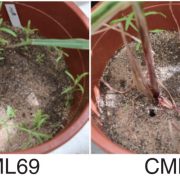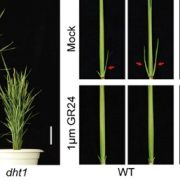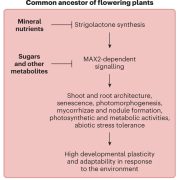Tree or bush? It’s all in the hormones
 Much of our understanding of the molecular underpinning that control shoot architecture comes from studies of annual plants such as Arabidopsis, pea, and rice. This new work by Su et al. investigates shoot branching in a long-lived tree, silver birch (Betula pendula). They started with a naturally occurring bushy variant, which has a premature stop codon in a gene encoding a strigolactone (SL) biosynthetic enzyme, BpMAX1, and correspondingly low levels of SL. The bushiness of the SL-deficient mutants is due to a shorter stem along with increased outgrowth of higher-order branches; 13-year old mutant trees form up to seventh-order branches, while the wild-type trees max out at fourth-order branches. The authors then looked at auxin transport and auxin levels in the mutant and found that polar-auxin transport is unaffected. However, in wild-type plants there is an auxin gradient from tip to base, which is not observed in the bushy mutants. They used mathematical modeling to investigate the origin of this difference and concluded that the bushiness itself (shorter internodes and more growing tips) is sufficient to explain the increased auxin levels at the base, “with no requirement for differences in auxin synthesis, transport, or decay.” As the authors observe, understanding how branching is controlled in trees has a potential for economic impact, with tall unbranched trees being preferred for timber, and shorter branchier trees being preferred for fruit production. (Summary by Mary Williams @PlantTeaching) Proc. Natl. Acad. Sci. USA 10.1073/pnas.2308587120
Much of our understanding of the molecular underpinning that control shoot architecture comes from studies of annual plants such as Arabidopsis, pea, and rice. This new work by Su et al. investigates shoot branching in a long-lived tree, silver birch (Betula pendula). They started with a naturally occurring bushy variant, which has a premature stop codon in a gene encoding a strigolactone (SL) biosynthetic enzyme, BpMAX1, and correspondingly low levels of SL. The bushiness of the SL-deficient mutants is due to a shorter stem along with increased outgrowth of higher-order branches; 13-year old mutant trees form up to seventh-order branches, while the wild-type trees max out at fourth-order branches. The authors then looked at auxin transport and auxin levels in the mutant and found that polar-auxin transport is unaffected. However, in wild-type plants there is an auxin gradient from tip to base, which is not observed in the bushy mutants. They used mathematical modeling to investigate the origin of this difference and concluded that the bushiness itself (shorter internodes and more growing tips) is sufficient to explain the increased auxin levels at the base, “with no requirement for differences in auxin synthesis, transport, or decay.” As the authors observe, understanding how branching is controlled in trees has a potential for economic impact, with tall unbranched trees being preferred for timber, and shorter branchier trees being preferred for fruit production. (Summary by Mary Williams @PlantTeaching) Proc. Natl. Acad. Sci. USA 10.1073/pnas.2308587120







